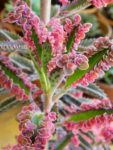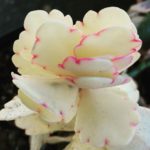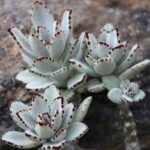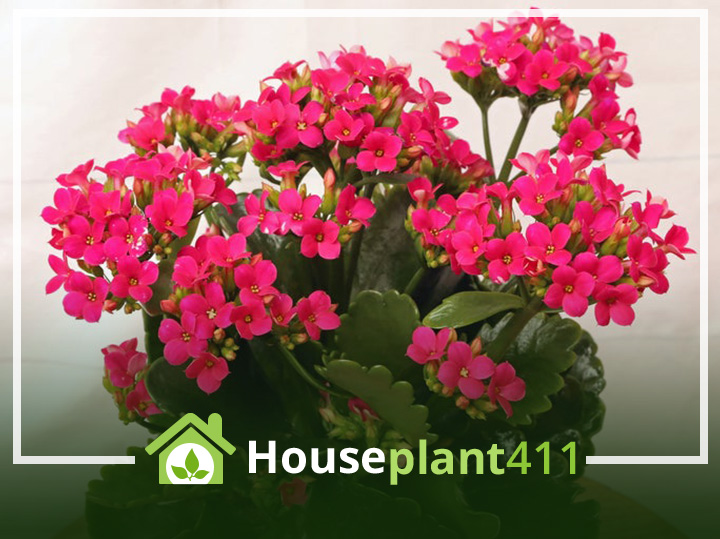About
At one time, a kalanchoe plant was only sold as a flowering Christmas plant. Today kalanchoe plants are sold in bloom throughout the year and are one of our most popular indoor, flowering houseplants. A kalanchoe plant, native to Madagascar, is a member of the Crassulaceae family and a close relative of the jade plant. This is an easy-care, succulent plant that grows extremely well in a bright spot in your home. Be sure to keep the temperature above 50° and be careful not to over water. Repot once the plant has finished flowering and has rested for about a month.
Kalanchoe Plant Description
The kalanchoe “blossfeldiana” is the most frequently sold variety. This is a short, bushy, upright plant, about 12” to 18” inches tall and 6” to 20” wide , with thick, oval-shaped, scalloped leaves. The long-lasting, star-like blooms on a kalanchoe blossfeldiana appear in clusters at the ends of sturdy stems throughout the year. The vibrant colored flowers come in red, orange, yellow, lavender, white, and pink. Some new varieties even have bi-colored flowers. The kalanchoe “mangginii” has fleshy, rounded leaves, and produces large, bell-shaped flowers in bright red and reddish/orange during the spring. The leaves of both varieties turn red when the plant is in very bright light. Best of all, the blooms on kalanchoe plants may last up to 8 weeks. If you are quick to deadhead the plant (pinch off dead flowers), you’ll encourage the plant to bloom more often and produce a greater number of flowers.
Kalanchoe Plant Varieties:
K. Pink Butterflies (K. Mother of Millions) has hundreds of bright pink baby plants along the leaf edges that fall off and root.
K. Calandiva is in a type of K.blossfeldiana but with larger and more beautiful flowers.
K. Albino has white scalloped leaves trimmed in pink
K. Paddle (flapjack paddle plant) has thick, leathery, paddle-shaped leaves. During the winter the leaves often turn bright red.
K. Panda has velvety, long, oblong leaves with brown decorative spots along the leaf edges.
K. Mangginii (Chandelier plant) has fleshy, rounded leaves, and produces large, bell-shaped flowers in bright red and reddish/orange during the spring.





K. Pink Butterflies K. Albino K. Paddle K. Panda K. Mangginii
Conclusion
A kalanchoe is a wonderful indoor plant to perk up your home during the long winter months. The shorter the days and the longer the nights, the more flowers a kalanchoe plant produces. Kalanchoes are also a perfect gift for someone who loves flowering plants but doesn’t have very much time to take care of it. Keep in mind, however, that all varieties of kalanchoe plants contain cardiac glycosides and are poisonous plants and must be kept away from small children, cats, dogs, and other pets. Read more about common houseplants that are poisonous in my book Don’t Feed Me to Your Cat: A Guide to Poisonous Houseplants.
Plant Care
Light
How much light for a kalanchoe plant: A kalanchoe plant needs bright, indirect light and can even tolerate direct sun during the fall, winter, and spring. Direct sun in the summer is too intense and burns the leaves. The blooms on a kalanchoe plant are photo-periodically induced. As the days get shorter and a kalanchoe experiences longer periods of darkness, the plant produces more flowers.
Water
How to water a kalanchoe plant: The succulent kalanchoe plant has plump leaves that store water for long periods of time. These plants are easily over-watered which results in root-rot. Always allow the top 50% of the soil to dry-out before watering a kalanchoe. If the soil is exceptionally dry, sit the plant in a deep saucer of water for about ten minutes; this not only prevents over-watering, but keeps the leaves dry. Wet leaves encourage plant diseases such as leaf spot or powdery mildew.
Fertilizer
How to fertilize a kalanchoe: Fertilize monthly when the plant is actively growing with a fertilizer high in nitrogen diluted to 1/2 the recommended strength. If the soil is very dry, moisten the soil with plain water before fertilizing; this prevents the plant food from burning the roots.
Temperature
Best temperature for a kalanchoe plant: Indoor kalanchoe plants like warm temperatures between 60°-85°f (15.6°-18.3°c). Low temperatures below 40°f (4.4°c) can damage or kill a kalanchoe plant within a few hours. Keep these plants away from cold drafts and open windows during the winter.
Humidity
Humidity for a kalanchoe: Kalanchoes grow well in regular to low household humidity. When the humidity is too high, these plants develop plant diseases such as leaf spot or powdery mildew.
Flowering
Flowering tips: Removing faded blooms as soon as they appear encourages more flower development. Starting in October, keep a kalanchoe plant in total darkness for up to 14 hours a day. This encourages the plant to bloom even more.
Pests
Kalanchoe plant pests: A kalanchoe plant is fairly pest resistant. When placed outdoors for the summer, they may attract mites, scale, and aphids. These plants are very sensitive to chemical insecticides. When treating a kalanchoe for a pest infestation, use the “Green Solution”, yellow sticky cards, insecticidal soap, or Neem oil. You can read about all of these products and how to make the Green Solution in the Glossary of the website.
Diseases
Kalanchoe plant diseases: A kalanchoe plant may get leaf spot disease and powdery mildew. The best way to prevent these plant diseases is to keep the leaves dry and provide good air circulation around the plant. Read more about how to identify and treat these plant diseases in the glossary of the website.
Soil
Best soil for a kalanchoe plant: Use a light soil composed of peat moss, sand, and perlite that drains well for a kalanchoe. When using a basic, store-bought potting soil, be sure to add an equal amount of sand for good drainage.
Pot Size
Pot size for a kalanchoe plant: Kalanchoe plants are sold in 4″ and 6″ pots. They rarely need to be in a container larger than 8” wide and 6” deep. Kalanchoe containers must have drip holes in the bottom so excess water can drain out. If the pot is too large and the soil stays wet too long, the roots die.
Pruning
How to prune a kalanchoe plant: Remove dead or dying flowers as soon as they appear. Cut bare bare stems to keep the plant full and bushy.
Propagation
How to propagate avalanche plant: Stem cuttings, plant division, and offsets are the best way to propagate a kalanchoe plant.When using stem tip cuttings, be sure to allow the cut end of the stems to dry out for 24 hours before planting them; this prevents the cuttings from developing root rot.
Resting Period
Kalanchoes need a month or two of rest starting at the end of September. Place your plant in a cool (around 65°f /18.3°c), low-light spot and keep the soil dryer that usual. After six weeks, return the plant to a warm, bright location and resume normal watering. This technique helps a kalanchoe produce more flowers.
Special Occasion
Kalanchoes make great presents since, unlike cut flowers, they bloom for years.
Poisonous Plant Info
A Kalanchoe is a poisonous plant and is toxic to cats and dogs. They belong to a group of plants that contain naturally-occurring poisons that affect the heart. The toxins in kalanchoe plants are similar to digitalis or digoxin, a common heart medication used in both human and veterinary medicine. The severity of the injury depends upon the amount of plant eaten. All parts of the plant are considered toxic, even the water in the vase of cut kalanchoe flowers is dangerous.
FAQ
Kalanchoes do very well outside as long as you keep them out of the direct sun and out of the rain. Be sure to bring them indoors before the weather starts to get cold and check for bugs!
It sounds like your kalanchoe may have a fungal infection. Fungal infections are usually caused by water dripping on the leaves or very high humidity. Remove the diseased leaves, keep water off the leaves, increase the air circulation around the plant, and move your kalanchoe to a less humid location.
The best way to prune a kalanchoe is to cut the stems back to aabout 4″ above the soil line. After you prune the plant, place it in bright indirect light. It should become full and bushy in a short time.
Absolutely not! Do not throw out your kalanchoe once the flowers die. With proper care, kalanchoes bloom on and off all year for many years.

